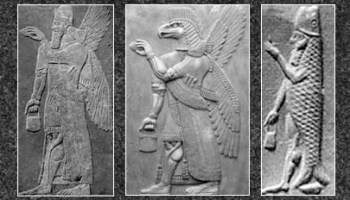We will consider a paper written by Estonia’s University of Tartu’s Amar Annus, “On the Origin of Watchers: A Comparative Study of the Antediluvian Wisdom in Mesopotamian and Jewish Traditions,” Journal for the study of the Pseudepigrapha, Vol 19.4 (2010 AD): 277-320 (find my series here).
The abstract and conclusion denotes Annus’ scholarly and also personal conclusions:
In the article, it is argued that the origin of Watchers derives from the Mesopotamian mythology of the antediluvian sages (apkallus). More precisely, it is proposed that the mythology of Watchers and their sons the giants derived from inverted versions of various Mesopotamian myths and beliefs about apkallus.
On Annus’ view, the “Jewish authors” of Genesis 6 and the apocryphal Book of Enoch (aka 1 Enoch or Ethiopic Enoch) were writing a “parody” which played upon “trends in Mesopotamian demonology.”
He notes that the apkallu were “very probable predecessors and a source of origin for the Jewish Watchers.” The term Watcher is employed by the Book of Enoch to describe the sons of God fallen Angels within Genesis 6. Annus considers Genesis 6 and the Enoch text as “folklore” and holds that, as already touched upon, “the Jewish authors were borrowing from Mesopotamia…in a creative and polemical spirit.”
This is because “ancient Mesopotamian intellectual tradition gives a divine origin in the antediluvian age to all priestly sciences” and envisages that the pre-flood period was one of revelation as “the basis of all later knowledge was laid down” and subsequently, “sages were culture-heroes, who brought the arts of civilization to the land.” Thus, the claim is that the Jewish authors turned this on its head.

He concludes that “The Book of Watchers apparently belongs to the same layer of Jewish polemical literature, which also depicted Daniel as a scholar in the court of the Babylonian king…the Book of Watchers may belong to the same period as that of the book of Daniel.” Note that he is dating these texts based on that which he determines apparently belongs together; we will come to how Daniel plays into this, in Annus’ view.
Lastly on this point, he notes:
The birth of the oral lore about Watchers must belong to a period in history, when the Jewish culture was extensively exposed to Babylonian influences. An obvious candidate for such a period is the Babylonian exile.
Thus far, I simply wanted to note the manner whereby he attempts to assign dates to these texts. His point, as well will see further, is that the Jews who had been banished to Babylon concocted tales that were meant to counteract the Mesopotamian culture in which they found themselves captives.
The seventh antediluvian king is said to have been Enmeduranki aka Enmeduranna, the king of Sippar, who was the “founder of the guild of barus, or Babylonian diviners.” The timeline is thought to coincide with the lifespan of the Biblical Enoch, seventh from Adam (Genesis 5:23-24).
A sixth century AD Nestorian monk named Cosmas Indicopleustes’ work Topographia
Christiana 12.3 states:
The writers of Chaldaean history, more ancient and living farther east, have mentioned in their works both the deluge and the building of the Tower, since they saw that Tower with their own eyes under the process of construction, being no doubt well aware that the men of that time, in fear of another flood, erected it for themselves as a place of refuge and safety.
But the men of later times, when they read Moses also, and found that Noah, in whose time the deluge occurred, was the tenth from Adam, they feigned that they also had ten kings…
For some reason, Indicopleustes reckons Enoch to be the tenth from Adam yet in any case: he get to the point as to why all ancient cultures have within their most ancient and formative myth and legend similar stories about creation, a garden, a flood, etc. which is because it happened, it was known and when humanity became divided after the Tower of Babel event they took this common knowledge which eventually came to vary on this or that point, “they saw…with their own eyes…”
Anar Annus’ notes:
Cosmas’ account shows that already the ancient scholars were conscious of the congruence between Jewish and Mesopotamian antediluvian histories…stating that the Chaldaeans learned from Moses. It goes without saying that from our contemporary perspective, Mesopotamia clearly provided the model, which the biblical writers quite creatively followed and modified.
This is another tool in Annus’ bag for determining dates of authorship, borrowing and parody, “our contemporary perspective.”
Annus notes that king of Babylon Nebuchadnezzar is viewed as a “distant scion of kingship, seed preserved from before the flood, offspring of Enmeduranki, king of Sippar” and that “By identifying certain traditional archenemies as descendants of Watchers, the Jewish authors once again gave a polemical thrust to the Mesopotamian concept of the ruler as ‘seed preserved from before the flood” which in the Jewish rewrite becomes corrupt, fallen, evil seed.
~~~~~~~~~~~~~~~~~~~~~~~~
A plea: I have to pay for server usage and have made all content on this website free and always will. I support my family on one income and do research, writing, videos, etc. as a hobby. If you can even spare $1.00 as a donation, please do so: it may not seem like much but if each person reading this would do so, even every now and then, it would add up and really, really help. Here is my donate/paypal page.
Due to robo-spaming, I had to close the comment sections. However, you can comment on my Facebook page and/or on my Google+ page.
Twitter: #AmarAnnus, #Watchers, #Nephilim
Facebook: #AmarAnnus, #Watchers, #Nephilim
